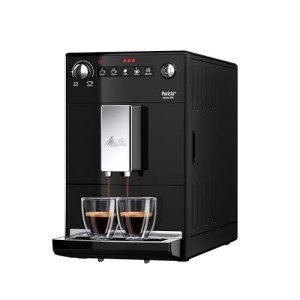Heat Exchange Espresso Machines: A Comprehensive Guide
Espresso machines have evolved substantially throughout the years, dealing with the needs of home baristas and coffee specialists alike. Among these machines, heat exchange espresso machines have actually acquired popularity due to their capability to provide constant performance and exceptional brew quality. In this article, we will explore the operations, advantages, and crucial features of heat exchange espresso machines, offering an extensive understanding for both possible buyers and coffee lovers.
Comprehending Heat Exchange Technology
Heat exchange espresso machines run on an unique concept that enables synchronised water heating for brewing and steaming. They are equipped with a single boiler that utilizes a heat exchanger system. This feature is substantial as it enables users to brew espresso while steaming milk concurrently, promoting efficiency in the coffee-making process.
How Does a Heat Exchange Espresso Machine Work?
The procedure begins with the machine's water inlet filling the boiler. As the water warms up, it turns to steam. The innovative heat exchanger uses hot steam to heat additional water in a separate passage designed particularly for the brew group. This means that water can reach the perfect developing temperature without waiting on the boiler to change. The key actions include:
- Water Fill: Water is drawn into the boiler.
- Heating Process: The boiler heats up as water is converted into steam.
- Heat Exchange: Steam warms water in the heat exchanger tube.
- Developing: Water from the heat exchanger is pressed through coffee premises, drawing out the flavors required for a rich espresso.
This procedure allows for quick temperature adjustments and improved coffee extraction.
Benefits of Heat Exchange Espresso Machines
Heat exchange espresso machines offer several advantages, especially for those aiming to optimize their coffee experience. Here are some key benefits:
- Simultaneous Brewing and Steaming: Users can brew espresso while steaming milk, making it ideal for busy cafes and home baristas who value effectiveness.
- Temperature Stability: The boiler's steam pressure helps maintain a stable temperature level, which is vital for constant espresso extraction.
- Flexibility: The design permits fast switching in between developing and steaming, making it much easier to produce various coffee beverages, from lattes to cappuccinos.
- Easy to use: Models frequently feature accessible controls, making it possible for both newbies and knowledgeable baristas to produce quality drinks.
- Professional Quality: Heat exchange machines are frequently utilized in commercial settings, offering users with high-quality developing performance in the house.
Key Features to Look for in Heat Exchange Espresso Machines
When considering the purchase of a heat exchange espresso machine, there are numerous functions that a person need to take into account:
- Build Quality: Look for machines made of durable products, such as stainless-steel or brass, ensuring durability.
- Boiler Size: A larger boiler will hold more water and sustain greater output gradually.
- PID Temperature Control: This function helps keep constant brew temperature levels, which can boost the coffee-making procedure.
- Group Head Design: Machines with a saturated or semi-saturated group head supply better temperature stability.
- Relieve of Use: User-friendly interfaces and intuitive controls boost the total experience for baristas at all skill levels.
- Steam Wand Quality: An excellent steam wand with proper insulation and flexibility permits much better texturing of milk.
- Water Reservoir Size: Depending on your requirements, think about how typically you wish to refill the water reservoir.
Comparison of Popular Heat Exchange Espresso Machines
To much better understand the options readily available in the market, listed below is a contrast table of some popular heat exchange espresso machines:
| Machine Model | Boiler Size | PID Control | Price Range | User Ratings |
|---|---|---|---|---|
| Profitec Pro 700 | 2.0 L | Yes | ₤ 2,000-₤ 2,500 | 9.5/ 10 |
| Rocket Espresso R58 | 1.8 L | Yes | ₤ 2,400-₤ 2,800 | 9.4/ 10 |
| Elekta Bianca | 1.8 L | Yes | ₤ 2,500-₤ 3,000 | 9.6/ 10 |
| La Spaziale S1 Vivaldi II | 1.5 L | Yes | ₤ 1,800-₤ 2,200 | 9.2/ 10 |
| Bezzera Magica | 1.2 L | No | ₤ 1,600-₤ 1,800 | 9.0/ 10 |
Frequently Asked Questions About Heat Exchange Espresso Machines
What is the main distinction in between a heat exchange and a dual boiler espresso machine?
While both types can brew espresso and steam milk at the same time, dual boiler machines have separate boilers for developing and steaming. In contrast, heat exchange machines make use of a single boiler and a heat exchanger to attain the same function.
Are heat exchange machines suitable for beginners?
Yes! Buy Coffee Maker are created with easy to use functions, making them available for newbies. With correct guidance and practice, users can quickly produce quality espresso.
What type of maintenance do heat exchange espresso machines require?
Regular maintenance consists of descaling, cleaning the boiler, examining seals and gaskets, and keeping the group head tidy. Routine upkeep ensures longevity and constant performance.
Can I use a heat exchange machine for various types of coffee beverages?
Absolutely! Heat exchange machines allow users to produce a variety of coffee beverages, consisting of espresso, lattes, cappuccinos, and more.
Heat exchange espresso machines represent a mix of development and custom, providing coffee enthusiasts with the tools required for crafting the perfect cup. Their capability to concurrently brew and steam, combined with precise temperature level control, makes them an engaging option for both home baristas and specialists. With the right knowledge on functions and maintenance, users can unlock a world of beautiful coffee experiences, making sure that each sip is as delightful as the last.

